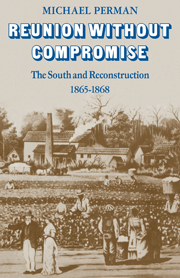Book contents
- Frontmatter
- Contents
- Preface
- Part I Conciliation and conflict
- Part 2 Encouraging Southern loyalty, 1865
- Part 3 Seeking Southern cooperation, 1866
- 6 Anticipation
- 7 The South courted
- 8 ‘Masterly inactivity’
- Part 4 Demanding Southern acquiescence, 1867–1868
- Epilogue: The irrelevance of the moderates, 1865–1868
- Appendix: Registration and voting statistics for the Southern State Constitutional Conventions, 1867–8
- A note on sources
- Index
8 - ‘Masterly inactivity’
Published online by Cambridge University Press: 05 August 2012
- Frontmatter
- Contents
- Preface
- Part I Conciliation and conflict
- Part 2 Encouraging Southern loyalty, 1865
- Part 3 Seeking Southern cooperation, 1866
- 6 Anticipation
- 7 The South courted
- 8 ‘Masterly inactivity’
- Part 4 Demanding Southern acquiescence, 1867–1868
- Epilogue: The irrelevance of the moderates, 1865–1868
- Appendix: Registration and voting statistics for the Southern State Constitutional Conventions, 1867–8
- A note on sources
- Index
Summary
The outcome of the struggle between President and Congress for control over the formulation of reconstruction policy was to be decided by the elections of 1866. As a preparation for this decisive contest, the Philadelphia convention was of the utmost importance. Johnson laid the groundwork very carefully. Just before the convention met, Congress was presented with a report from General Gordon Granger on conditions in the South and also with a scathing exposé of corruption in the Freedmen's Bureau compiled by Generals Steedman and Fullerton. Immediately after the convention, the President issued his proclamation of 20 August declaring the insurrection at an end in Texas as well as the other States mentioned in the 2 April Proclamation. Then Andrew Johnson embarked by train for Philadelphia, New York, Cleveland, and Chicago on his ‘Swing Around the Circle,’ an attempt to take ‘My Policy’ to the people and rally the conservatives of the North for the fight to save the nation in the polling-booths during October and November.
Dignity and enthusiastic crowds attended the procession as far as Cleveland, but, thereafter, especially on the return trip, Johnson's passionate and combative extemporaneous speaking produced entertainment for hecklers as well as rumors of assassination-attempts. Retreating with confusion and denunciation, Johnson appealed to his countrymen's ‘brains, and not to your prejudices; to your reason, and not your passions;’ yet this ironically engendered the very opposite, passionate derision.
- Type
- Chapter
- Information
- Reunion Without CompromiseThe South and Reconstruction: 1865–1868, pp. 229 - 266Publisher: Cambridge University PressPrint publication year: 1973



